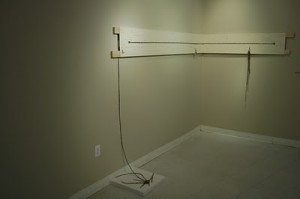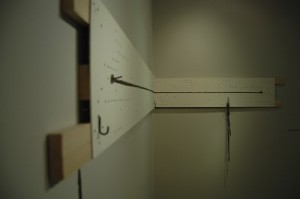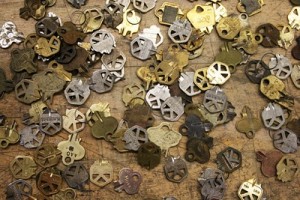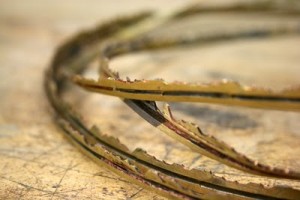Barbara Smith has work in the current Artist Hall exhibition, Commonplace: Objects by Barbara Smith & Ryan Takaba, which ends Sunday, April 3, 2011. Smith recently received her MFA in Metal from State University of New York-New Paltz. She was gracious enough to take the time to explain her thoughts and process behind her works, which use a very common object: keys.

What do we do when a key becomes obsolete? When we move, get a new car, or buy a new padlock? Keys are familiar and intimate objects. We carry them in a pocket or a bag. When we are not in transit, we set them aside in a special place. We search for them when they are lost. We give or share a key with someone we trust. The keys on a key ring are given order based on function. They are grouped based on place or frequency of use. They get me where I need to go and to where I should be. My key ring contains a narrative that only I can decode.

To make TR47 USA, SC4, DO NOT DUPLICATE, Brown, (blank), Master, 622, DO NOT COPY SC9 (J&L), Chicago, Illinois, COO68, (blank), (blank), Master, DO NOT DUPLICATE, J, 23, AR4, USA1, GM, E71, I purchased a box of discarded keys. The box came from Joplin, Missouri, marked “Rattle OK, keys.” The contents of the box provoked a melancholic adoration. Organized on rings, the keys were intensely personal assemblages of potential. For two days I simply looked at the various configurations and reflected upon the individuals who had once used them. To who, where, and what did these keys belong? Key chains told me about interests, travels, donations, brand loyalty, and banking preferences. I looked at them long enough to know which set of keys gained two or more people access to the same places. Here were people’s lives. These lives were faceless, nameless, and timeless. While these keys could tell me a great deal, there was even more that I could never know. The history contained within them was both strange and familiar. Removing them from the key rings felt like dismantling a life. The act of disrupting the order was accompanied by an acute sadness. In touching them, I touched drawers, locks, and hands; in touching them, I did not know what I touched.

Keys are quiet carriers of intimate, personal narratives. This latent information scattered as I removed the keys from their assigned places on the key rings. Individual keys became absent and unknowable bodies and spaces. After cutting the blade away from every key, these fragments were recombined to give them a collective life. I repetitively cut the keys apart and soldered them blade to blade. Progress was measured in small increments: the length of a line grew an inch at a time, and a pile of key heads on my bench grew to be a mound. Hundreds of keys combined to create a new, yet recognizable, form. People and places met in a linear archive of tactile data.

When I sit down to make, my intention is to account for existence. Keys are intensely personal artifacts of this existence. In TR47, each blade is a point along a timeline of thought and experience. Time, place, loss, and memory are reconsidered on both an individual and a collective level. When I gather, remake, and recombine keys, I participate in a fiction to both understand my own moment and express an understanding of my eventual absence.
Barbara Smith
https://www.borderlinebarbie.com/

